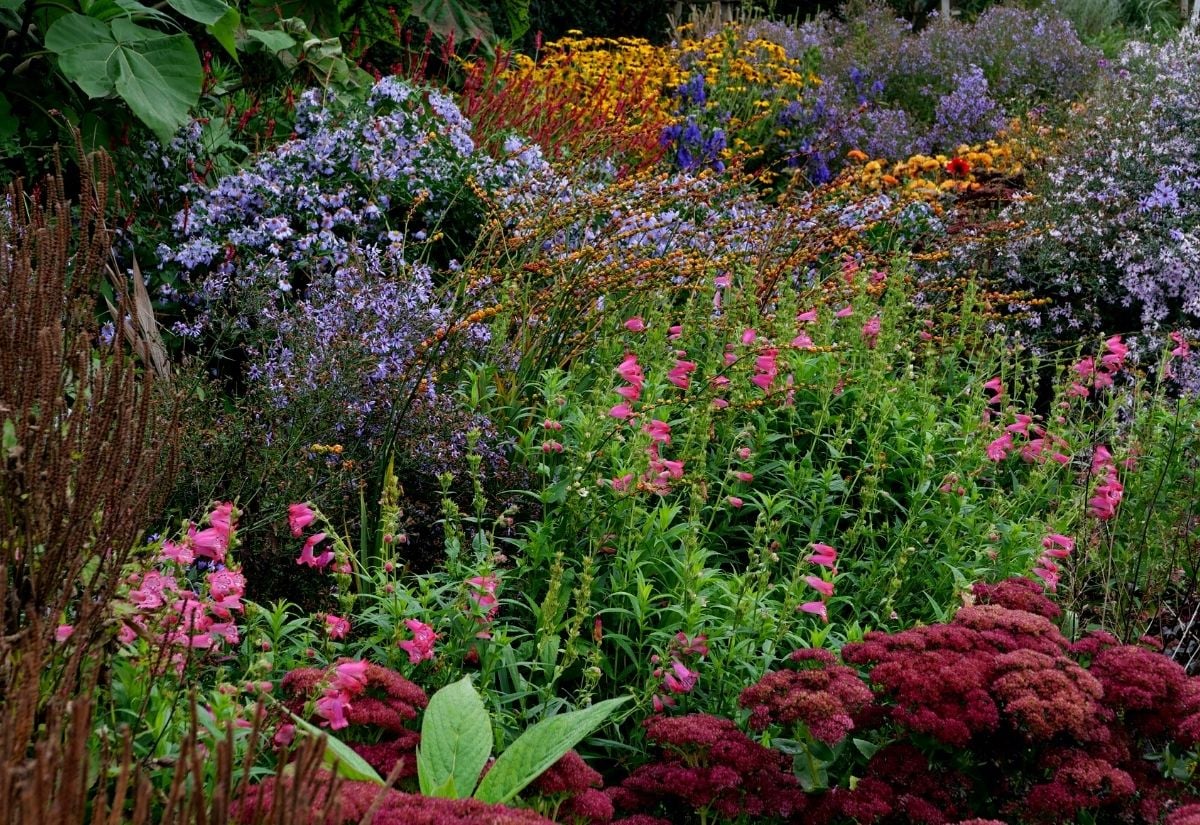
Fall is the season of falling leaves and warm colors, but there are many flowering perennial plants begin blooming in the fall and continues through early spring.
If the foliage turning red is not enough for your garden during this season, you can rely on fall-flowering beauties like anemone and stonecrop to keep your green space alive and vibrant, even in this melancholic season.
There are fewer perennials that blossom in fall rather than spring, but there are enough to keep your garden blooming until the first frost. Many fall flowers, especially herbaceous perennials, like chrysanthemums and balloon flower are in fact late bloomers.
Still, there are far too many perennials that produce flower in the late season, and choosing one you will fall in love with or that suits your growing zone may be a challenge.
If you want to make the best of the flowers on your plants in the autumnal season, you will find that they often lack the “right setting”. This is especially true for informal borders and flower beds.
Why? Put simply, the foliage may either be too colorful and “steal the show” from the flowers, or it may (and often will) be too scarce.
So, in order to give your flowers the right backdrop this season, use evergreen plants with rich foliage to accompany them. This will also keep your composition fresh and lively, even as the first frost approaches.
We’ve rounded some of our favorite fall blooming perennials to grow in your garden according to what “feeling” and artistic effect you want to create, but also of the growing needs of the plants.
Whether you need them for beds, borders or even to climb on fences and trellises, these fall-flowering perennials will bring an instant burst of color to your garden without a pause until frost sets in.
Here are 15 fall blooming perennials to turn Your garden Into An autumn floral spectacle.
1: ‘Strathmore’ Gentian (Gentiana ‘Strathmore’)
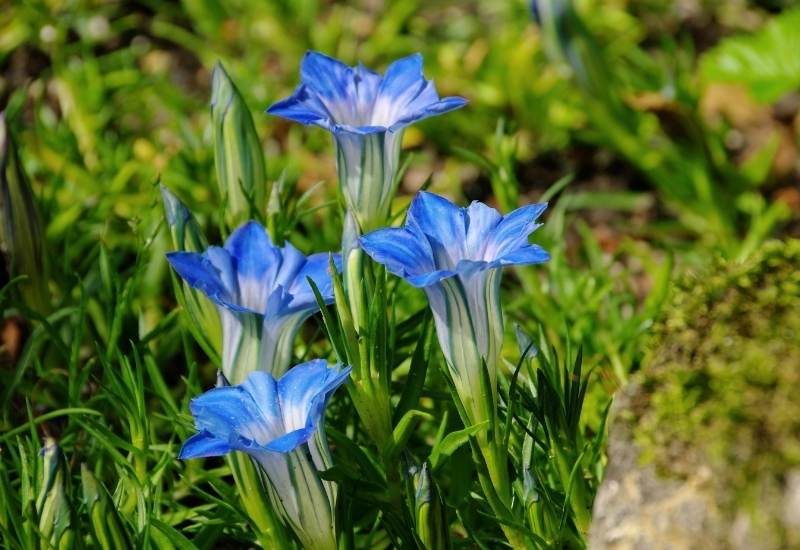
Gentians are autumn-blooming perennials that grace many mountainous areas of the world with their funnel shaped flowers that grow very close to the soil and look up, into the sky.
You will find this mat-forming perennial growing near stone crops on Alpine meadows, and they have a carpeting habit which makes them perfect for rock gardens as well as low flower beds.
‘Strathmore’ is a variety with a special delicacy. It takes the blue color so typical of this flower and turns it lighter, shading it into light blue and even white.
It is a generous bloomer, and from late summer through the whole of fall you will have lots of these very elegant looking sky blue trumpets in your garden – year after year.
2: Sneezeweed (Helenium spp.)
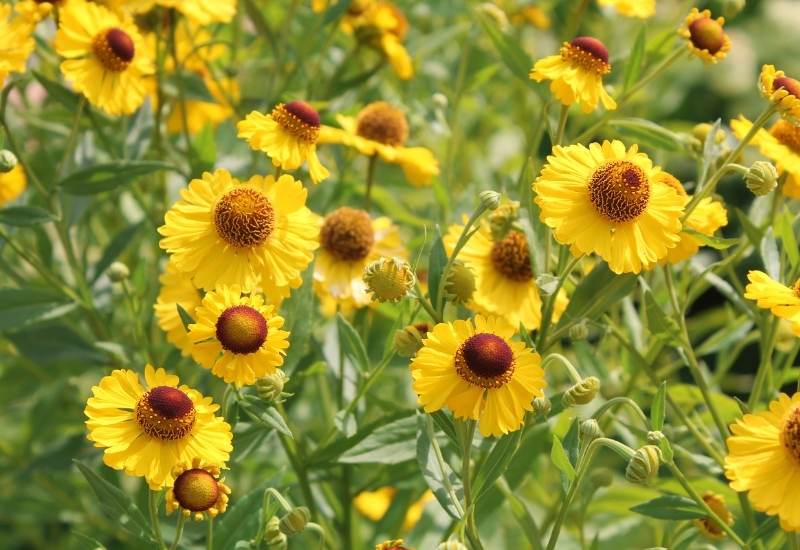
If you want to make the most of the flaming and warm colors of fall, sneezeweed’s flowers are absolute champions of warm, dark yellows, expressive oranges and passionate reds.
These clump-forming perennials with daisy looking flowers are bloom very profusely from mid summer till the first frost, filling gardens, wild meadows and borders with energy and string feelings.
There are prize winners like the saffron yellow with crimson dashes ‘Fueresiegel’ variety, which has won the Award of Garden Merit of the Royal Horticultural Society, mainly monochromatic ones like the velvety vermillion red ‘Moerheim Beauty’ and dichromatic ones like the bright yellow and red purple ‘Königstiger’.
What its more, you cam enjoy their hot colors in fairly cold areas too, as they are quite hardy.
3: Daylily ‘Autumn Accent’ (Hemerocallis ‘Autumn Accent’)
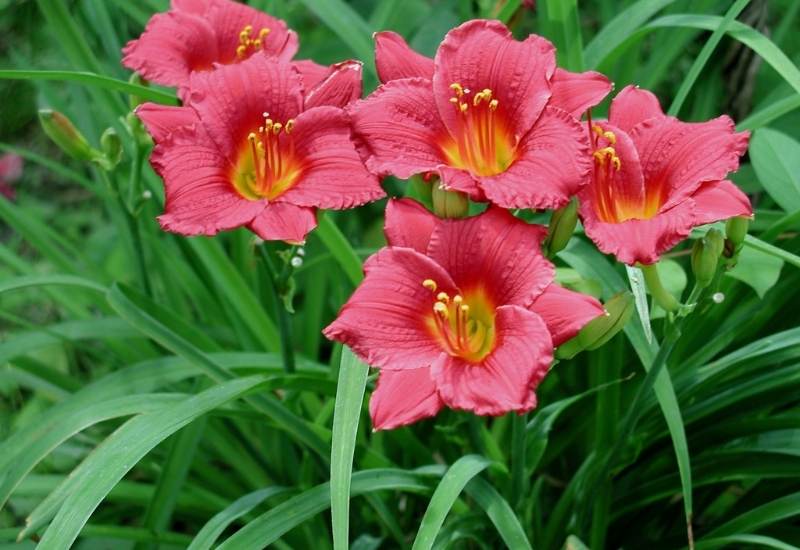
Daylily’s flowers only last 1 day, true, but these perennials are so generous that you will get new blossoms every day!
Large, showy and very colorful, these flowers come on top of very dense foliage, each soft and leaf being roughly 3 feet long (90 cm).
While most daylilies blossom in summer, there are some wonderful late bloomers, like ‘Autumn Accent’, which has warm coral red tepals and a golden center.
This is a plant that can fill a border with volume and foliage and bright colors at the same time. If you want, there is also the classically orange ‘Autumn Pride’ variety that likes to flower from late summer to fall.
- Hardiness: daylily is hardy to USDA zones 3 to 9.
- Light exposure: full Sun or partial shade.
- Size: 2 to 3 feet in height and spread (60 to 90 cm).
- Soil requirements: well drained loam, clay or sandy soil with ph from fairly acidic to fairly alkaline. It is drought and heat tolerant as well as very low maintenance.
4: St John’s Wort (Hypericum x inodorum)
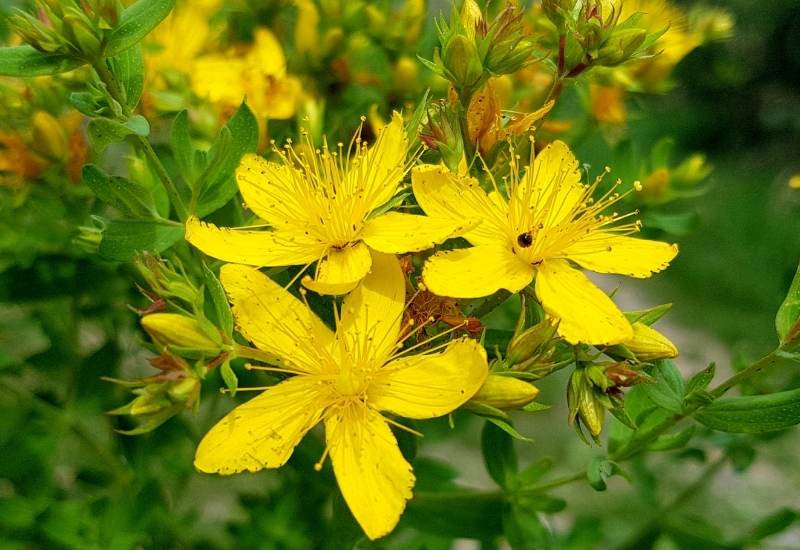
St John’s wort is famous for the outstanding medicinal properties of its red colored essential oil. But from late summer to mid fall, you can also enjoy the beauty of this autumn bloomers many and showy yellow and star shaped flowers.
With long stamens and a very large ovary at the base of the pistil, these flowers look lovely on top of the green pointed leaves…
What is more, your hedges, borders, flower beds or even river banks and slopes will benefit from the beautiful berries that follow the booming season.
And they are not all the same! ‘Magical Universe’ has yellow berries that turn brownish-red when mature; ‘Magical White’ has a Christmas feel with its white berries; ‘‘Red Flame’ has crimson red berries while those of ‘Magical Pumpkin’ are coral red…
- Hardiness: St John’s wort is hardy to USDA zones 7 to 9.
- Light exposure: full Sun or partial shade.
- Size: 3 to 5 feet in height and spread (90 to 150 cm).
- Soil requirements: it is very unfussy; it will grow in loam, chalk, clay or sandy soil with pH from slightly acidic to neutral, preferably between 5.5 and 7.0. It is drought resistant.
5: California Lilac (Ceanothus ‘Autumnal Blue’)
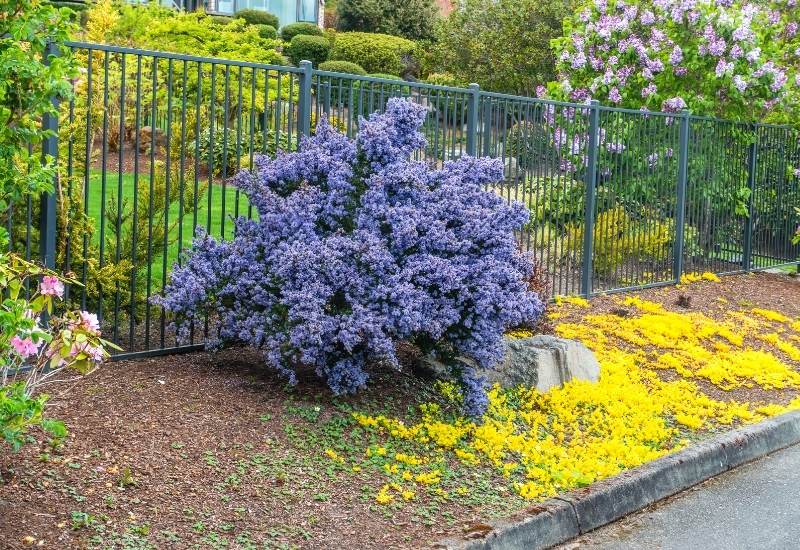
If you want a fast growing evergreen shrub to fill a large gap in your hedges, borders or to cover an unsightly wall, California lilac will do it quickly.
But it will also add a sea of sky blue flowers from late summer to fall. They will come on long racemes and while each individual flower is small, they are so abundant that the whole shrub will turn blue!
This winner of the Award of Garden Merit by the Royal Horticultural Society is also irresistible to bees, butterflies and hummingbirds.
So, surprise your guests with this lesser known but beautiful and generous perennial and get a carpet of flowers in a season when they may find it hard to get any at all.
- Hardiness: California lilac is hardy to USDA zones 8 to 10.
- Light exposure: full Sun. It also likes a sheltered position from the wind.
- Size: up to 10 feet in height and spread (3 meters)!
- Soil requirements: well drained loam or sandy soil, with acidic pH. It will tolerate drought.
6: Chilean Potato Bush (Solanum crispum ‘Glasnevin’)
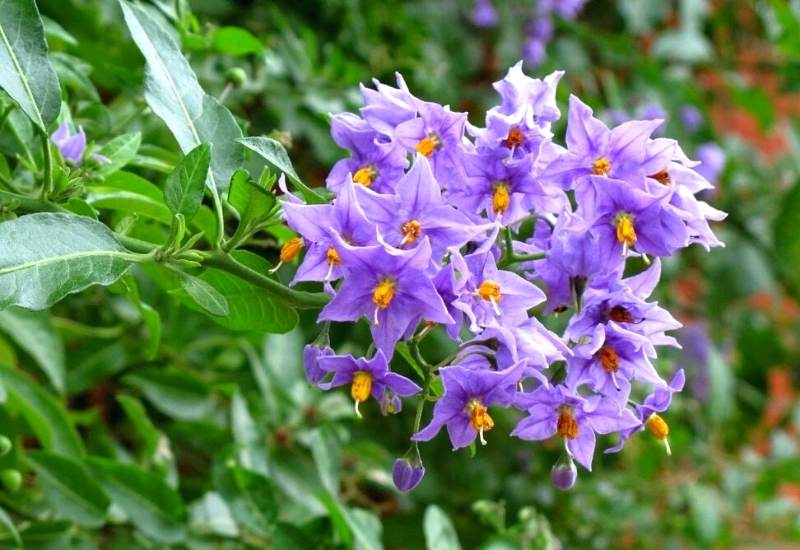
To cover a pergola or arbor, grow Chilean potato bush and you will get lush green foliage most or even all the year and a lot of intense lilac purple star shaped flowers from summer through fall.
The thick gold colored anthers at the center of each flower just extoll the vivid hue of the petals themselves.
Each cluster can have a few dozen of them, and this vine will keep producing these sweet scented flowers for months. And lots of them!
After the blooming season, this winner of the Award of Garden Merit by the Royal Horticultural Society will cover in pale yellow fruits, which, unfortunately, you cannot eat. And yes, if you were wondering, it is related to the humble potato.
- Hardiness: Chilean potato bush is hardy to USDA zones 9 to 11.
- Light exposure: full Sun.
- Size: 15 to 20 feet tall (4.5 to 6 meters) maximum, but you can keep it shorter if you need. It will spread to about 4 to 5 feet (120 to 150 cm).
- Soil requirements: well drained chalk, clay or sandy soil. It likes the soil slightly alkaline or neutral, but not acidic.
7: ‘Sonic Bloom Pink’ Weigela (Weigela florida ‘Sonic Bloom Pink’)
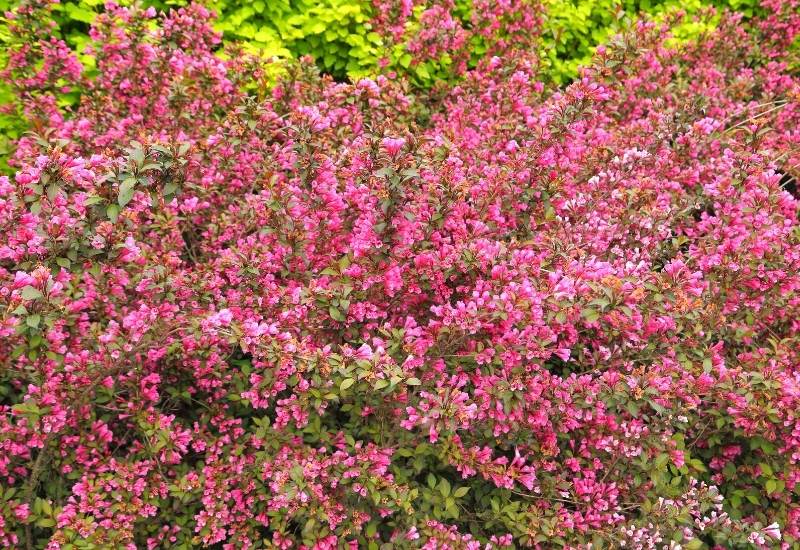
‘Sonic Bloom Pink’ weigela is a small sized shrub with oval leaves of the most tender green color. Its thin branches tend to go upright.
The problem is that you can hardly see the leaves when in bloom, as the thin branches literally cover in magenta pink bell shaped flowers of the most vibrant shade.
The chances are that you won’t see many leaves at all most of the year if you plant this beautiful perennial in your hedges or borders, because it will start blooming in spring and it will keep going with no break till the very first frost!
This is in fact a famous variety for its long and massive blooms. Its tenacity and abundance will literally surprise you, but they will keep your garden bright and colorful too.
- Hardiness: ‘Sonic Bloom Pink’ weigela is hardy to USDA zones 4 to 8.
- Light exposure: full Sun.
- Size: 4 to 5 feet in height and spread (120 to 150 cm).
- Soil requirements: it is very unfussy. It will grow well in well drained loam, clay, chalk or sandy soil. The pH can be slightly alkaline to acidic and it tolerates heavy clay.
8: Japanese Anemone (Anemone hupehensis)
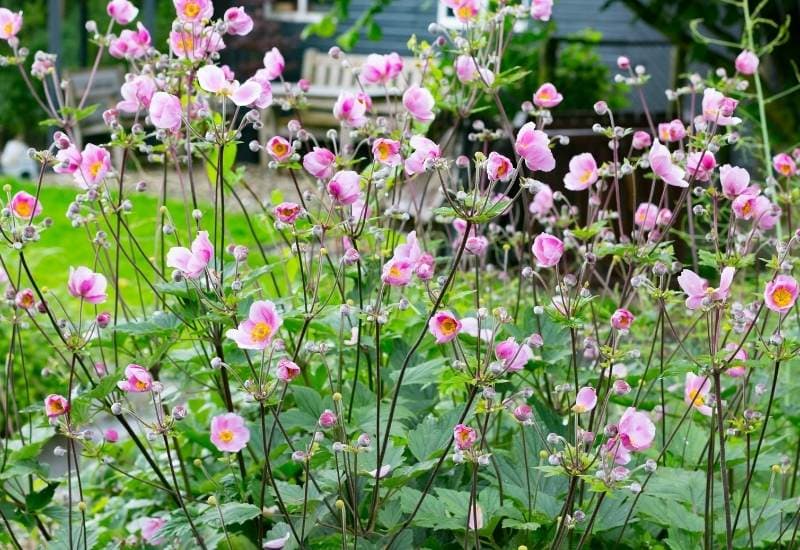
Japanese anemone is a hardy, lovely long-lived perennial that will grow back year after year and fill your borders and beds with flowers from summer all the way through fall.
While they are called Japanese, they are actually from China, but they are now common in gardens all over the world.
This dappled shade loving flowering perennial can survive the winter cold with minimal maintenance.
Their showy and romantic looking flowers will come in great numbers above the beautiful basal leaves and stay there for months on end.
The main color range goes from magenta pink (e.g. ‘Praecox’) to white (e.g. ‘Honorine Jobert’), via rose with the award winning ‘Königin Charlotte’ (actually Anemone x hybrida ‘Köningin Charlotte’).
- Hardiness: Japanese anemone is hardy to USDA zones 5 to 8.
- Light exposure: full Sun or partial shade.
- Size: 4 to 5 feet tall (120 to 150 cm) and 2 to 3 feet in spread (60 to 90 cm).
- Soil requirements: it likes humus rich, well drained and moist soil. It is adaptable to loam, chalk, clay and sandy soil, with pH from slightly acidic to slightly alkaline. It is salt tolerant and wet soil tolerant too.
9: ‘Cambridge Scarlet’ Bee Balm (Monarda didyma ‘Cambridge Scarlet’)
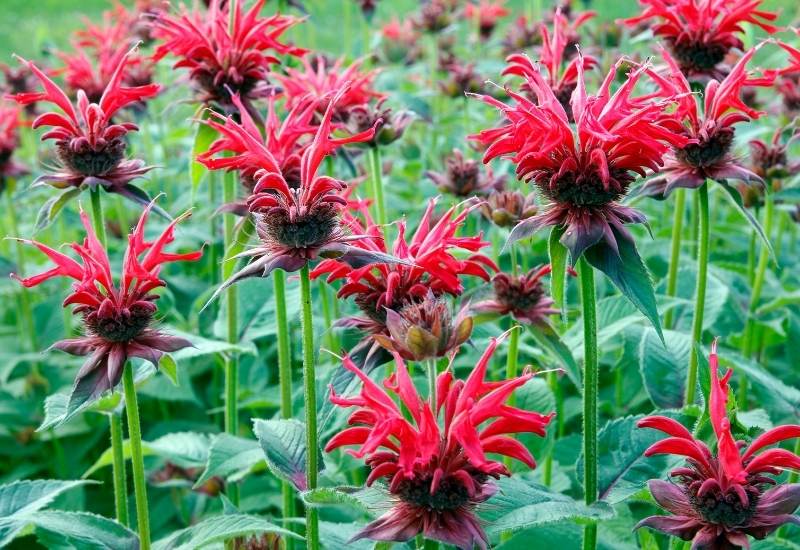
Most bee balm varieties will stop blooming as fall starts; depending in where you live, you may get so e extra flowers after summer.
But ‘Cambridge Scarlet’ is different: this perennial will keep blooming all the way from mid summer to the first frost.
With crazy looking and large flowers that can reach 3.5 inches across (8 cm) and of the most beautiful shade of ruby red, the flowers will grow above the foliage on tall and upright stems.
This makes it an excellent flower for wild and natural looking gardens, in borders and beds, but also prairies and containers.
- Hardiness: ‘Cambridge Scarlet’ bee balm is hardy to USDA zones 4 to 9.
- Light exposure: full Sun or partial shade.
- Size: 2 to 3 feet tall (60 to 90 cm) and 1 to 2 feet in spread (30 to 60 cm).
- Soil requirements: you can grow it in well drained loam, clay, chalk or sandy soil with pH from fairly acidic to fairly alkaline. It is heavy clay tolerant.
10: Hooker Inula (Inula hookeri)
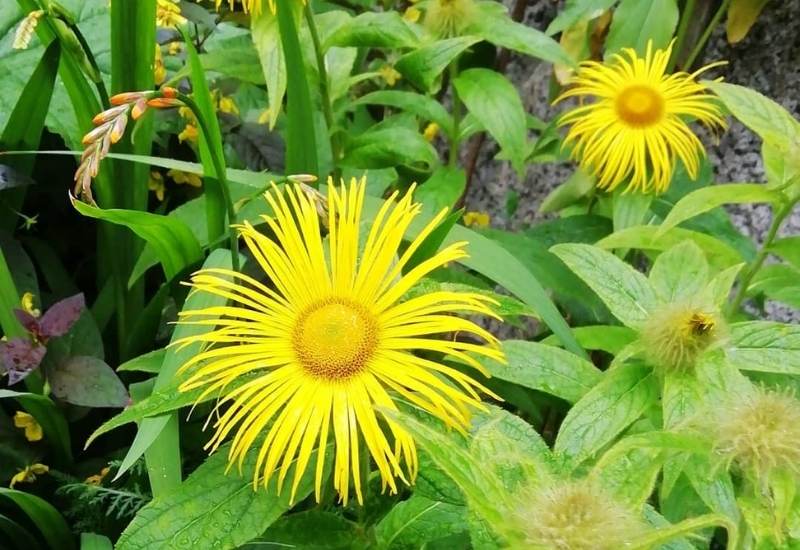
If in fall you miss the bright energy of the summer Sun, you cam still have it in your flower beds and borders if you grow hooker inula. In fact, this perennial’s flowers have a fluffy golden disk and many, thread like bright yellow rays all around.
Of course, you can see how they look like little suns! Well, not that little, as they are 3 inches across (8 cm)!
It is a lesser known garden perennial which will look great and “summer like” in most informal gardens.
What is more, this is a plant that naturalizes very easily and propagates spontaneously, which makes it a perfect choice to fill wide grassy gardens with color.
- Hardiness: hooker inula is hardy to USDA zones 4 to 8.
- Light exposure: partial shade or dappled shade.
- Size: 2 to 3 feet tall (60 to 90 cm) and 1 to 2 feet in spread (30 to 60 cm).
- Soil requirements: it can grow in most types of drained but humid soil: loam, clay, chalk or sandy soil with pH from slightly acidic to slightly alkaline.
11: Mountain Cranesbill (Geranium pyrenaicum)
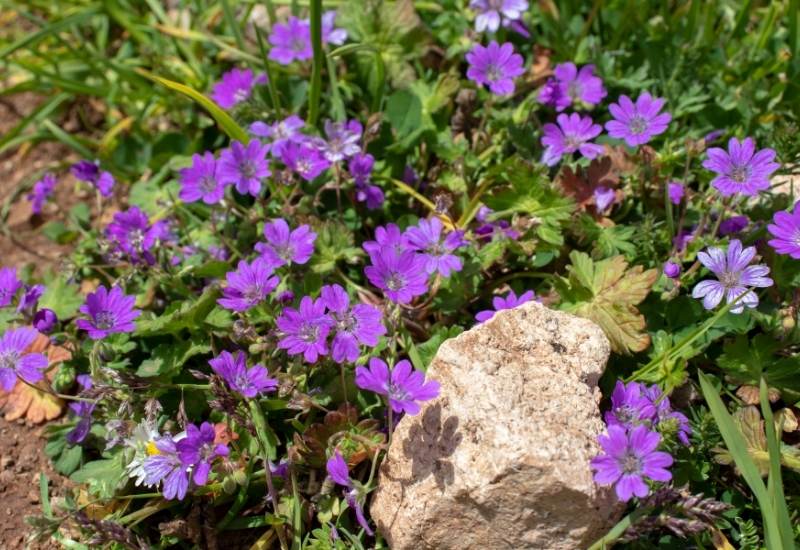
A classic perennial for borders and rock gardens but also for containers and terraces, cranesbill has a blooming strength that will amaze you!
In fact, it will start in late spring and flower all through the summer months. And it will keep going… in fact, it will not stop until the first frost.
There are a few varieties, like the deep violet blue ‘Bill Wallis’, the pastel mauve ‘Karmina’ or the bright dark magenta purple ‘Giuseppii’) or the sky blue ‘Orion’. These are only some of the beautiful varieties you can grow easily and expect great results to keep your garden flowering all through fall.
- Hardiness: cranesbill is hardy to USDA zones 5 to 9.
- Light exposure: full Sun or partial shade.
- Size: 1 to 2 feet tall (30 to 60 cm) and 2 feet in spread (60 cm).
- Soil requirements: it is very adaptable to well drained loam, chalk, clay or sandy soil with pH from alkaline to acidic. It is drought resistant.
12: ‘Autumn Tryst’ Iris (Iris germanica ‘Autumn Tryst’)
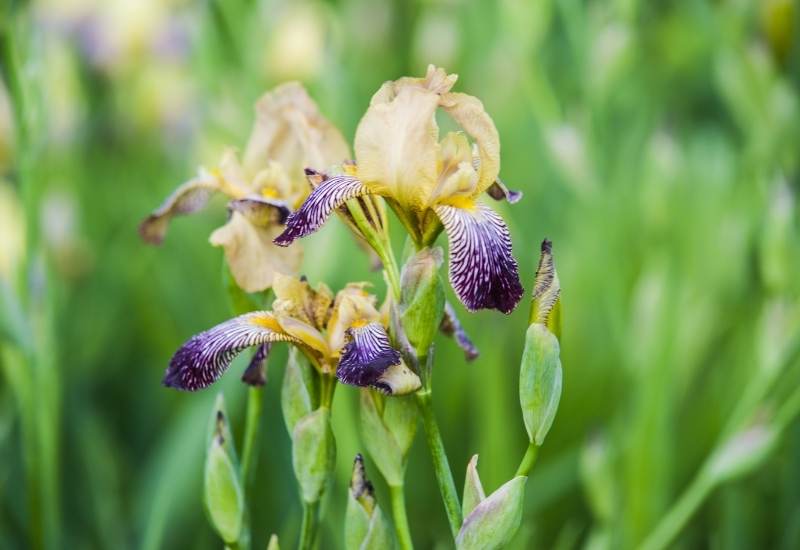
Many irises will blossom in spring, but some reblooming varieties, like ‘Autumn Tryst’ will bloom again and again and they will keep your garden brightly colored all through fall.
‘Autumn Tryst’ has the typical shape of a bearded iris, with the beard (fluffy surface) on the fall (lower petal) and upright standard (upper petal).
The beard is golden yellow, while the fall is white with a lavender purple edge. This color pattern is then repeated in the standard, but with less white and more purple.
This late-season bloomer is a very showy flower, excellent for most garden settings. You can use it in rock gardens, gravel gardens, urban and courtyard gardens but also in a border or flower bed and even in cottage gardens.
- Hardiness: ‘Autumn Tryst’ iris is hardy to USDA zones 3 to 9.
- Light exposure: full Sun.
- Size: 2 to 3 feet tall (60 to 90 cm) and 1 to 2 feet in spread (30 to 60 cm).
- Soil requirements: it will grow in well drained loam or sandy loam with pH from acidic to neutral.
13: Passion Flower (Passiflora spp.)
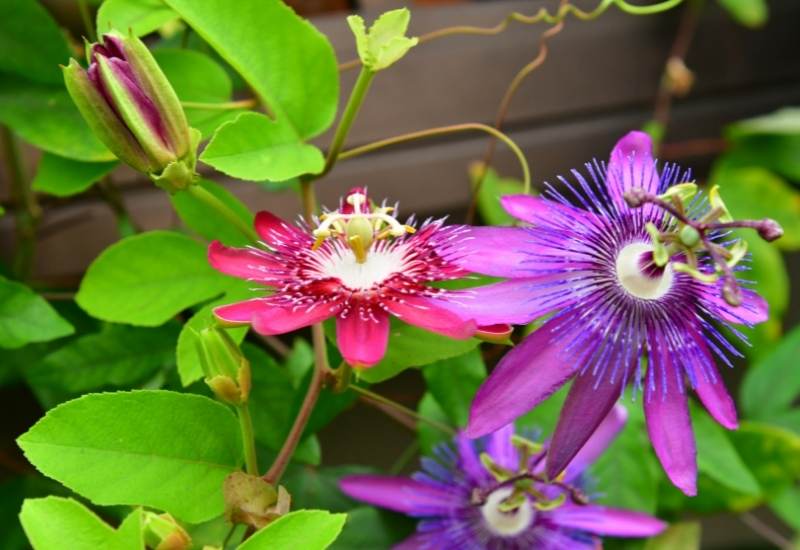
I wonder why people don’t grow more passion flowers? They are stunning, exotic, they never fail to wow viewers, perennial and they bloom all the way from late spring to fall!
And you can also eat its fruit, which is beyond delicious and super vitamin rich…
Maybe because they are so beautiful and so exotic people think that they are hard to grow, but the opposite is true.
As long as you live in a fairly warm region, this strong and hassle free plant will survive winters, but in colder climate you need to keep your passion flowers safe from winter damage. In the USA, you can grow this perennial vine all along the West Coast and most of the East Coast, for example.
No gazebo, pergola, trellis, fence or wall will ever look the same, even in fall with a passion flower growing on it.
- Hardiness: passion flower is hardy to USDA zones 8 to 11.
- Light exposure: full Sun or partial shade.
- Size: 10 to 30 feet in height and spread (3 to 9 meters).
- Soil requirements: it grows in well drained loam or sandy loam with pH between 6.1 and 7.5.
14: Cockscomb (Celosia spp.)
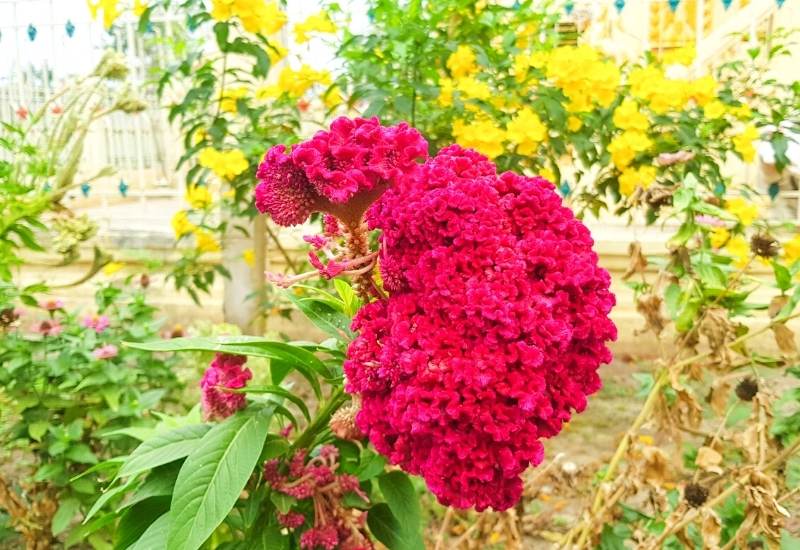
Cockscomb is highly decorative thanks to its vibrant and colorful plumes (inflorescences) that will stay on all through fall.
They are most commonly of very decided cardinal colors, like pure red, pure bright orange, or pure yellow. But there are others with more hued shades, especially within the pink-red-purple range.
Typically grown as hardy-annuals, Celosias are tender perennials in USDA plant hardiness zone 10 to 12. But you if the garden is mulched and the plants are protected from the freezing temperatures of winter cockscomb will return every spring or early summer and bloom until early fall.
Beautiful but also easy to grow, cockscomb are perfect for borders and cottage gardens, but they also look great in pots and containers, where they will keep blooming for months on end. You can grow it as both a perennial and an annual flowering plant.
- Hardiness: cockscomb is hardy to USDA zones 10 to 12.
- Light exposure: full Sun.
- Size: 2 to 3 feet tall (60 to 90 cm) and 1 to 2 feet in spread (30 to 60 cm).
- Soil requirements: it will grow in well drained loam, chalk or sandy soil with pH from slightly acidic to slightly alkaline. It is drought resistant.
15: False Sunflower (Heliopsis helianthoides)
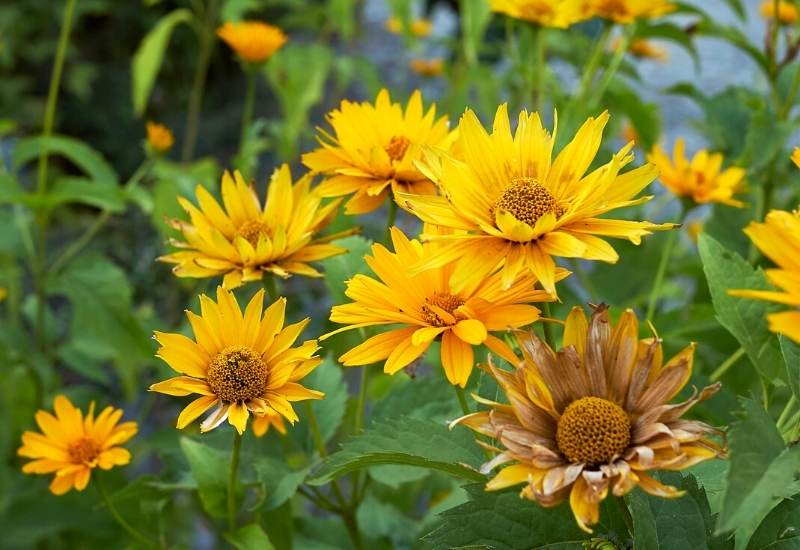
Let’s look at fall with positivity and a summer feel… Grow false sunflower in your garden and you will have the same feeling and bright vibrancy of energy and color as you get looking at sunflower fields in summer.
Yes, because false sunflower is like a small version of its more famous relative, but not less beautiful or energetic.
These perennials has many daisy shaped flowers, of the brightest yellow color, and it can fill wild prairies as well as borders or flower beds from summer to fall.
Some cultivars like ‘Venus’ also offer fairly large flowers, that can reach 5 inches in diameter (12 cm).
- Hardiness: false sunflower is hardy to USDA zones 3 to 9.
- Light exposure: full Sun. It will tolerate some light shade though.
- Size: 3 to 6 fret tall (90 to 180 cm) and 2 to 3 feet in spread (60 to 90 cm).
- Soil requirements: it will grow in well drained loam, chalk, clay or sandy soil, with pH from fairly acidic to fairly alkaline. It is drought resistant, heavy clay tolerant and it grows well in rocky soil.
Forever Fall
So, fall does not need to be a season with few flowers scattered here and there, like leftovers from summer.
And if your preference is for perennials, there are quite a few you can grow in your garden or on your terrace that will fill your life with colors and even a summer feel during this season.
Choose your plants and colors well; this way you can decide how you will live your fall time…
With false sunflower you will have a second summer, for example, while with sneezeweed you will feel all mellow and melancholic…
Just like fall.

Written By
Amber Noyes
Amber Noyes was born and raised in a suburban California town, San Mateo. She holds a master’s degree in horticulture from the University of California as well as a BS in Biology from the University of San Francisco. With experience working on an organic farm, water conservation research, farmers’ markets, and plant nursery, she understands what makes plants thrive and how we can better understand the connection between microclimate and plant health. When she’s not on the land, Amber loves informing people of new ideas/things related to gardening, especially organic gardening, houseplants, and growing plants in a small space.
